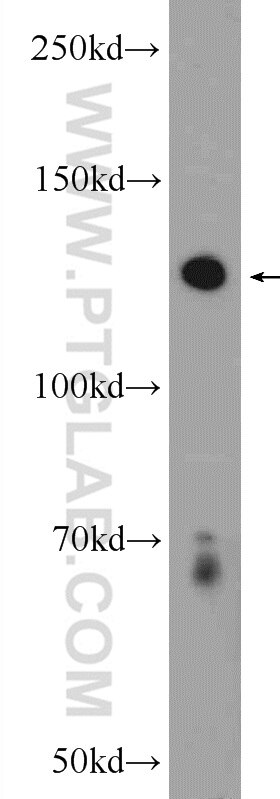Tested Applications
| Positive WB detected in | Jurkat cells |
Recommended dilution
| Application | Dilution |
|---|---|
| Western Blot (WB) | WB : 1:200-1:1000 |
| It is recommended that this reagent should be titrated in each testing system to obtain optimal results. | |
| Sample-dependent, Check data in validation data gallery. | |
Published Applications
| WB | See 1 publications below |
| IHC | See 1 publications below |
Product Information
14204-1-AP targets PLEKHH2 in WB, IHC, ELISA applications and shows reactivity with human, mouse, rat samples.
| Tested Reactivity | human, mouse, rat |
| Cited Reactivity | human |
| Host / Isotype | Rabbit / IgG |
| Class | Polyclonal |
| Type | Antibody |
| Immunogen |
CatNo: Ag5409 Product name: Recombinant human PLEKHH2 protein Source: e coli.-derived, T-HIS Tag: 6*His Domain: 1-357 aa of BC063310 Sequence: MAELSEPEGPVDWKERCVALESQLMKFRVQASKIRELLAEKMQQLERQVIDAERQAEKAFQQVQVMEDKLKAANIQTSESETRLYNKCQDLESLIQEKDDVIQNLELQLEEQKQIRIQEAKIIEEKAAKIKEWVTVKLNELELENQNLRLINQNQTEEIRTMQSKLQEVQGKKSSTVSTLKLSEGQRLSSLTFGCFLSRARSPPQVVKSEEMSKISSKEPEFTEGKDMEEMEIPEKSVDNQVLENNRGQRTLHQTPCGSEQNRKTRTSFATDGGISQNSGAPVSDWSSDEEDGSKGRSKSRCTSTLSSHTSEEGVQCSRMGSEMYLTASDDSSSIFEEETFGIKRPEHKKLYSWQQE Predict reactive species |
| Full Name | pleckstrin homology domain containing, family H (with MyTH4 domain) member 2 |
| Calculated Molecular Weight | 168 kDa |
| Observed Molecular Weight | 120 kDa |
| GenBank Accession Number | BC063310 |
| Gene Symbol | PLEKHH2 |
| Gene ID (NCBI) | 130271 |
| RRID | AB_2878027 |
| Conjugate | Unconjugated |
| Form | Liquid |
| Purification Method | Antigen affinity purification |
| UNIPROT ID | Q8IVE3 |
| Storage Buffer | PBS with 0.02% sodium azide and 50% glycerol, pH 7.3. |
| Storage Conditions | Store at -20°C. Stable for one year after shipment. Aliquoting is unnecessary for -20oC storage. 20ul sizes contain 0.1% BSA. |
Background Information
PLEKHH2 is a 1491-residue intracellular protein highly enriched in renal glomerular podocytes. PLEKHH2 is one of two previously uncharacterized PLEKHH proteins encoded in the mammalian genomes. A PLEKHH ortholog has also been described in Drosophila, Caenorhabditis elegans, and zebrafish. In C. elegans, the loss of the protein was found to cause variable axon guidance defects.
Protocols
| Product Specific Protocols | |
|---|---|
| WB protocol for PLEKHH2 antibody 14204-1-AP | Download protocol |
| Standard Protocols | |
|---|---|
| Click here to view our Standard Protocols |




